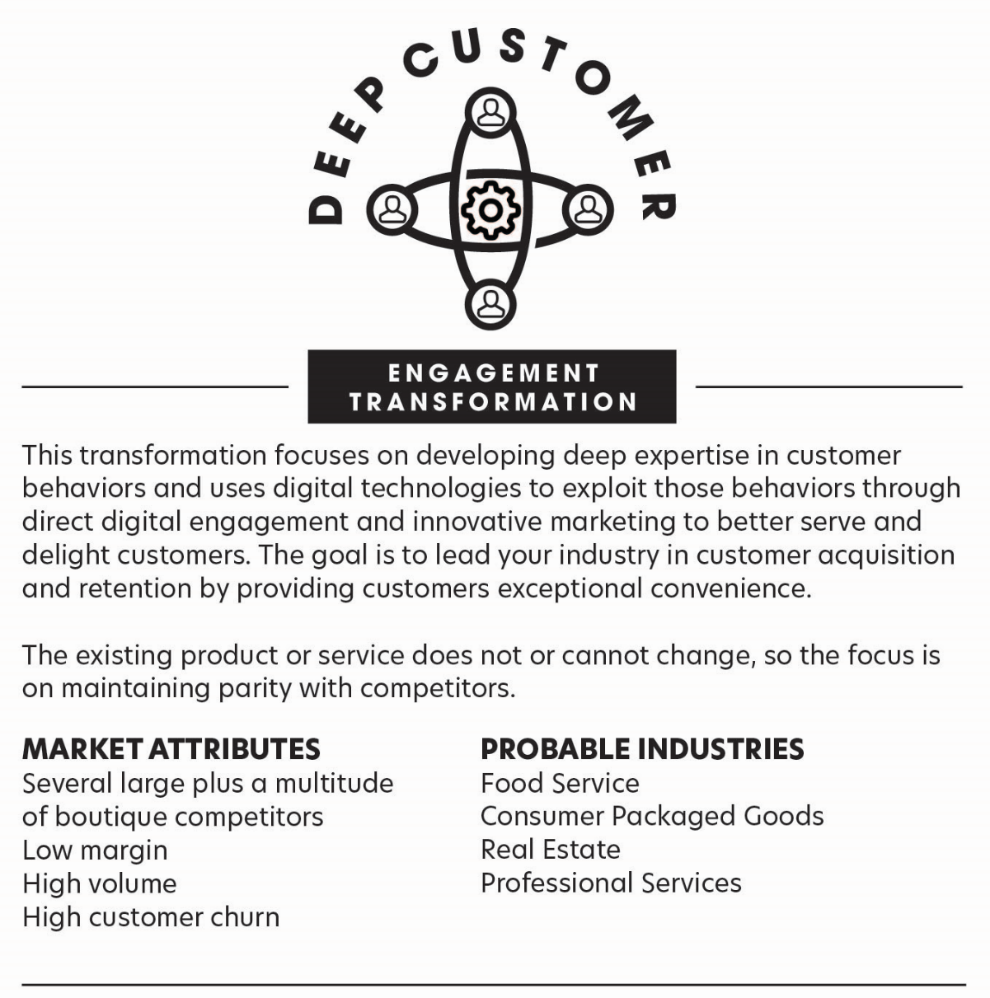Transformation #1 Of 4: Customer Engagement
As we outlined in the Domino’s case study, organizations that pursue this strategy develop deep expertise in customer behaviors and exploit those behaviors through direct digital engagement and innovative marketing without making significant changes to existing products and services. (Figure 20)

The point of investing in deep customer engagement is that you achieve differentiation through engagement, not through the product or service. This strategy focuses on deep customer engagement and delightful customer experiences to maximize customer retention.
Because the organization does not change its core product, it typically will focus on simply maintaining product parity with competitors. It is increasingly more impactful to decrease product variants and focus on doing a better job of creating a deep and direct connection with customers. These businesses will often have high customer churn across the industry, which leaves an open space to roll up those customers using digital capabilities to better serve and delight them.
It is important to go direct to the end customer and deliver value above and beyond the product. Because the product does not vary, the organization must lead through superior customer relationships. A product or service that is highly differentiated can stand out in third-party channels, so it does not require the same investment in going deep on customer engagement. This means that working with partner channels that can augment the direct channels may eventually be accepted within the strategy, but they should never be the primary area of focus. Keeping customers tightly folded into your organization is the name of the game.
Investments in product improvements should be minimized, and the bulk of future investments should be in the successful execution of the following areas:
- Acquiring new customers to the digital channels owned by the organization through advertising but primarily through direct user and customer referrals,
- Maintaining customers relationships through digital engagement between transactions,
- Maximizing online reviews to prove to the market that your organization provides a wonderful experience, and
- Delivering recognized and desired value above and beyond the core product, such as faster delivery times and detailed product or service tracking.
The revenue model for this strategy will typically stay the same as before the digital transformation because customers will not usually pay for digital engagement. The increased revenue comes from growing the customer base and the number of transactions per year. As we will show later, a loyal customer base decreases the need for advertising spending.
The industries most likely to adopt this type of strategy include food Service, Consumer Packaged Goods, Real Estate, and Professional Services because they have a few traits in common:
- A few large market share holders competing with a significant presence of boutique providers that differentiate on small product variations.
- Low margins that make it difficult to change the cost of goods sold or bill of materials (BOM) for the product or service.
- Low margins that require high volumes to achieve the profitability necessary to overcome investments in manufacturing, warehousing, and distribution costs.
- Low product cost and a fragmented market of competitors that differentiate with small product variations. Increased product variants over the past few decades have significantly decreased the number of opportunities available to organizations that want to introduce another new variant.
- Customers are not locked into a long-term relationship with the organization, so investments must focus on capturing the customer’s attention at a moment of need.
In this strategy, it is critical to focus on data about the customer and their behaviors, such as:
- Customer acquisition data, which helps understand how customers found you, the cost of acquiring the customer, and their propensity to refer new customers.
- Activation rates, which track customer behavior on digital properties to understand what they do when they land on your site, and the probability they will convert to being a customer.
- Retention and loyalty data which assesses the factors that keep customers engaged with your products and services over a period of time.
- Customer demographic and identification data including name, address and other information that uniquely identifies each customer.
- Social graph data to help you understand the customer’s social networks, so you can leverage those networks to acquire new customers and maintain engagement with your products and services.
- Transaction history that helps determine customer preferences including cost, convenience, and choice.
- Customer satisfaction insights on how customers feel about your product and service through online reviews, comments, and net promoter ratings – both to monitor current customer satisfaction as well as to leverage those comments in marketing programs.
- Abandonment data to understand why customers stop using your products which is critical to maximize retention and re-engage former customers.
The emerging technologies that are most likely to be impactful in this type of strategy must drive greater choice, value, or convenience for end customers. Good places to start looking include:
- Chatbots and Natural Language Processing (NLP) to enable conversational commerce provides new ways to engage with end customers by letting customers either speak or text with robots that can help process orders or provide support.
- Data Analytics, machine learning, and Artificial Intelligence to better understand and engage with customers.
- Data security and privacy to protect customer data from being misused, mishandled, lost, or sold resulting in damaged relationships and lost trust.
The financial statements will change to address both the income statement and balance sheet. The income statement should see higher revenue growth rates on direct digital channels supported by higher expenses on sales and marketing. On the balance sheet side, under Generally Accepted Accounting Principles (GAAP) used in the United States, investments in new software development can be capitalized on the balance sheet and amortized on a straight-line basis over three to five years.